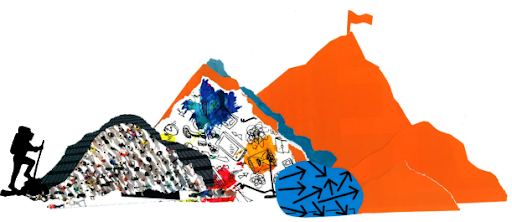
Written in collaboration with Niko Canner and Cynthia Warner for the Reimagining Capitalism newsletter published by Nina Montgomery.
As the world convulses with many forces of change, threatening the assets that organizations have built and opening up new possibilities to tackle structural problems, social entrepreneurs face a core dilemma: what is strategy’s role in a moment that demands dynamism?
From the wrenching economic disruption stemming from COVID-19 to the mobilization around calls for racial justice following the killing of George Floyd in May, the massive changes we’re experiencing make the limits of conventional strategic planning acutely visible. Staying locked into an overly linear roadmap of steps and sub-steps toward a goal is wholly inadequate for social entrepreneurs who need to make decisions today about whether and how much to change course -- whether because their strategy relied on assumptions that are no longer true, or assets that no longer hold value; or because there are once-in-a-generation windows of opportunity to seize (as the scholar and organizer Marshall Ganz tells us: "Opportunities occur at moments when actors' resources acquire more value because the environmental context changes"¹).
So what is strategy’s role in a world that demands dynamism? Should you keep the core of your strategy intact, making tactical decisions to address setbacks but adhering broadly to the picture you had before the world changed? Should you pivot, radically shifting theories of change -- or even your fundamental goals -- in response to events you’d never previously envisioned? Or should you chart a path in between, reaffirming core purpose and beliefs but building a new roadmap?
To answer these questions well, we go back to first principles, reflecting on the role that strategy plays in the dynamic work of social entrepreneurship; share our framework for thinking about strategy in terms of progression through a set of “eras,” which are like levels of a game, with each level opening up a more dynamic category of powers; and then use this framework to offer a set of thinking tools for the social entrepreneur wrestling with today’s unprecedented challenges and opportunities. By doing so, we explore a different approach toward strategic prioritization, one that connects the social entrepreneur’s ambitious vision for tomorrow to the agility and focus needed to take action today.
The Solutions Journalism Network
In 2013, David Bornstein had a vision for the newly founded Solutions Journalism Network: spread a new form of journalism -- rigorous reporting on what’s working to address social problems -- until this kind of reporting had the same ubiquity that investigative journalism has today. This ambitious goal would require a sea change in the ways that journalists, publications, and readers engaged in news stories. Journalists would need to produce breakthrough examples of the genre, which would achieve iconic status as “classics” of solutions journalism. Journalism schools would need to embed solutions journalism into their curriculum, making this kind of reporting a core element of developing one’s craft as a journalist. Readers would need to be able to evaluate the effectiveness of described solutions and consider how those results related to the conditions they experienced in their communities. For solutions journalism to achieve the ubiquity of investigative journalism, all these factors would need to be true.
Where to start? David and his co-founders Tina Rosenberg and Courtney Martin faced what has been defined as the essence of entrepreneurship: the act of pursuing goals outside your grasp, goals that live well beyond the resources you have today. The Solutions Journalism (SJN) team needed to develop conviction about the most impactful agenda to shape in the near term, in order to accelerate the trajectory of this new field.
There was no shortcut to their ambitious goal -- nor could they carefully plan out each step of the journey. They needed a way to sequence different strands of work over time and set some achievable milestones in the middle distance. And they needed to build their organization and network such that the work they were doing now would accelerate their progress later -- to quickly grow their capabilities and give them a shot at matching the size of their vision.
Thinking in “eras”
Eras-based strategic thinking asks the entrepreneur to think of her journey in terms of distinct stages, each one representing an advance to the next level of the game.
For each era, you ask: what is the bundle of achievements that, if attained, unlocks far greater possibilities for action? This is an exercise in identifying the small number of breakthrough accomplishments that lets your organization “graduate” from its current stage to the next: a more powerful place from which to advance your cause.
Identifying these pivotal achievements distinguishes the “work of now” from the “work of later.” SJN’s small founding team in 2013 defined the work of their first era as creating solutions journalism demonstration cases and building a small core of journalists passionately committed to this work. In their words:
We will graduate from Era 1 when:
- We’ve created powerful demonstration cases of “what good looks like” for solutions journalism, showing the impact this kind of reporting can have
- We’ve built a cohesive core of first-rate journalists committed to bringing this new kind of reporting into the world
The Solutions Journalism Network was then able to articulate the milestones -- a combination of external results and internal accomplishments -- that would signal they’d fulfilled the work of Era 1. Work that would undoubtedly be important later -- such as building a website curating the best solutions journalism globally -- but that wasn’t on the path to graduating from this era could be set aside. Thus, the team could stay laser focused, for example, on their partnership with the Seattle Times, where they worked with the newspaper’s Education Lab to support education solutions reporting.
Equipped with vivid demonstration cases, and having mobilized a group of journalists who were just as fiercely committed as the co-founders, the team could advance their work with new assets and new energy. This would be Era 2, with different work required to take SJN to a next level of impact. In their words:
In our second era, we will win the fight to establish a standard for what solutions journalism is and how it’s done. We will create a dynamic network, extending over many countries, that enables the successful development of solutions journalism as a practice, achieves much broader exposure/demand, and embeds solution journalism broadly and deeply in important institutional contexts.
Era 2 would have a different feel and focus from earlier work: a new set of pivotal achievements to accomplish, focused on building a network beyond the original core and developing much broader exposure. In Era 2, a website curating the best solutions journalism globally was indeed critically important and was pulled into focus (and successfully built -- see SJN’s Story Tracker).
Conceptually stringing together the work of different eras -- each representing a categorically higher level of impact from what their organization could do at present -- enabled the team to point their efforts along an arc that could credibly lead to their ambitious vision. From where they stood, the team couldn’t see vividly the details of every era along the arc, all the way to their end destination; this would have been an exercise in false precision. But they could be confident that their actions in the present were leading them toward their far-off beacon, creating the foundations for the leaps forward the organization would need to get there.
Embracing this tension between what’s “tight” and what’s “loose” is at the heart of eras-based thinking. On the one hand, we can only see so much from the starting line: our work toward the goal should open up new possibilities, build new capabilities, and develop new partnerships from which to advance to the next level. Like scaling a series of hills on the way to a mountaintop, it’s only once we’ve reached the top of the current hill that we can look out at the rest of the climb -- and see in new ways what’s required of us in the next stage of the journey.
On the other hand, we can’t focus only on the hillside in front of us, solving the problems of the landscape we can see now, building the right training regimen to ensure we’ll reach this particular hilltop -- only to find that the hill we’ve climbed has taken us farther away from our ultimate destination.
Strategy for social entrepreneurs demands we hold a picture of the whole climb -- how hills, or eras, might credibly lead one to the next, all the way to the final summit -- while also locating the hill we’re on and articulating those achievements that need focus, in order to continue scaling toward the top.

Dynamic strategy demands we hold a low-resolution picture of the whole climb, alongside a sharp focus on what’s required to reach the top of our current hill. Image credit: Tiffany Franke
An order of operations
With pivotal achievements articulated, entrepreneurs can establish clarity inside the era they’re working to graduate from. This creates focus about what deserves attention and what can wait -- not because it’s unimportant, but because it’s not relevant to what counts the most now. Particularly in times like the present moment, when many organizations face existential questions about their long-term survival, this ability to think clearly about what deserves focus and what should be deferred is essential.
We talk about an “order of operations” with the entrepreneurs with whom we work. In the development of an organization or endeavor, one should focus on priorities in the order of:
- First, survive. Ensure the health of the organization and don’t compromise core standards
- Then, focus on graduating from the era. Work towards those accomplishments that are necessary to graduate into the next era
- Next, focus on those things that might be rate limiting in later eras. For example, you might prioritize developing future capabilities that matter further out and have long lead times
- Achieve other objectives, beyond the first three. This might include options you see for achieving small increments of greater impact now, in the current era, or experimenting to expand the range of future options for the organization
As when observing an “order of operations” in mathematical expressions, you can’t progress to the next level of priority until you’ve dealt with the current one. If an organization is tackling “survive,” attention spent on any of the subsequent operations is wasted. If the requirements of “survive” are met, an organization can focus on the next “operation” -- those core accomplishments that are needed to graduate. Observing this order of operations enables leaders to consciously label what kind of mode their organization is in and how ambitiously, at present, they should be setting their vision.
Moving forward with clarity
The first half of 2020 has upended how we work and how we plan. Our environment is calling on social entrepreneurs to rapidly learn and evolve. It’s creating both existential challenges to our ways of executing, as well as windows of opportunity in which to reimagine old paradigms and make sudden leaps forward in the impact we can have -- if we can see them.
How do you practically sift through this noise for a signal about how to move forward? Depending on your assessment of what this moment means for your work, there are five different stances that a social entrepreneur might take -- listed below from the least disruptive to the most.
- Our critical path to reach the next era, the next level of the game, remains consistent. We should stay focused on our critical path, while keeping our minds open to the ways unfolding events present challenges we must solve to move ahead on this path or new tactical opportunities to advance this path.
- We are striving toward the same picture of the achievements to reach the next era, the next level of the game, but changed circumstances dramatically alter the path to get there from where we are today. While our high-level strategy remains consistent, our organization’s roadmap must shift significantly.
- Changed circumstances mean we are at a lower rung in the “order of operations,” level 1 -- survive. Our focus needs to materially shift to ensuring the organization can sustain itself and to making intentional decisions to ensure we uphold our core standards for how we run the organization. Once we’ve stabilized the organization’s health, we can get back to focusing on era graduation.
- While we’re pursuing the same fundamental purpose and vision that’s animated our work to date, we have a new picture of the achievements needed to reach the next level in the game as well as how to reach this level. This drives a significant shift in the strategy guiding our focus and choices.
- The world has changed in a way that requires us to redefine our own purpose and role. We’re pivoting to a new vision. We can draw upon assets that we’ve built on our journey so far -- indeed, that’s an important part of what fuels this redefinition of our vision -- but we need to fundamentally shift our strategy, thinking about new ends for our work as well as new means.
Great change creates high risk of under-reacting and high risk of over-reacting -- or responding with the right seriousness but the wrong mental model for what the change implies. By interrogating where on this ladder of five potential stances their organization stands, social entrepreneurs can anchor their strategy in a thoughtful assessment of how this moment meets the impact they seek to have in the world.
¹ “Leading Change: Leadership, Organization, and Social Movements” (chapter 19) in Nohria, Nitin, and Rakesh Khurana, eds. Handbook of Leadership Theory and Practice. Harvard Business Press, 2010.



